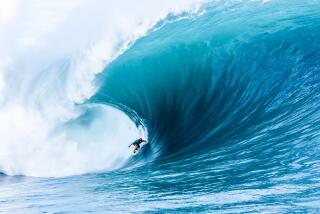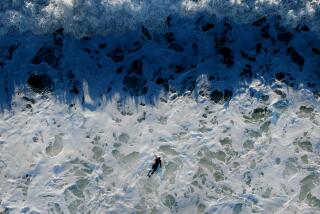Pro surfing is no day at beach
- Share via
For those on the outside looking in, the life of a professional surfer seems to be pristine beaches, exotic locations and the opportunity to earn a living on some of the best waves in the world.
For those who actually choose the career, however, the line of work isn’t as glamorous as it appears. Especially for the newcomers.
“I can think of a lot of downfalls,” said Nick Rosza, a 20-year-old from Oxnard who advanced to today’s round of 48 at the Honda U.S. Open of Surfing in Huntington Beach.
“Getting on an airplane for 21 hours isn’t fun for anyone. It costs a lot of money to travel, sometimes you have a lot of money, sometimes you’re broke, sometimes you get really sick.”
And the list goes on. Lost luggage, bouts with stingrays and unfamiliar food are just a few of the obstacles pro surfers encounter during their travels.
Rosza entered an event in Australia two years ago, despite torn ligaments in one of his big toes. He took off a protective boot to practice before the contest, but re-aggravated the injury. He then came down with mononucleosis.
“I just wanted to go home,” he said.
Eric Geiselman, a 20-year-old surfer from New Smyrna Beach, Fla., had a big scare during his first trip to Indonesia four years ago. He planned to meet with a group of friends at an island location, but it took 12 hours to get there by boat. He ended up making the trek in a 12-foot canoe with a 15-horsepower engine.
“I was out in the middle of nowhere, didn’t see land anywhere,” he remembers.
As it is with most international travelers, illness is one of the biggest downfalls. In addition to the viruses that can spread through an airplane, water-borne illnesses such as malaria are also considered occupational hazards.
“It will rain for a while and the river mouths flow out,” said Chris Waring, a 21-year-old from Seal Beach who won his heat in Thursday’s round of 96. “So you get sick.”
Waring felt flu-like symptoms two years ago while preparing to compete in Australia and vomited as he paddled out for his heat. Considering the time and money he spent to get there, Waring had no choice but to continue surfing. “You’ve just got to get over that and still ride the wave,” he said.
Getting accurate information regarding the time and location of events can also be inconsistent. More than once, Waring said he has shown up for an event in another country, only to learn the contest had been moved to another beach.
Occasionally, surfers will make it to an event on time, only to find out their surfboards were still in transit.
“I had to wait five days for my boards to show up at an event earlier this year,” said Patrick Gudauskas, a 22-year-old from San Clemente who also advanced with a victory in the round of 96.
Most surfers agree, however, the more time spent on tour, the less obstacles they encounter.
“Put in your time, the more experience you get, everything comes together,” Waring said.
Surfers with the most experience seemed to have an edge in Thursday’s round. Among the heat winners were World Championship Tour members Tim Reyes of Huntington Beach and Taylor Knox of Carlsbad, former WCT members Cory Lopez of Laguna Niguel and Kirk Flintoff of Australia and local standout Brett Simpson of Huntington Beach.
Sunny Garcia of Hawaii, making a bid to re-qualify for the WCT at the age of 38, was one of the few veterans who didn’t advance, finishing third in his heat. The final four heats of the men’s round of 96 begin today at 7:30 a.m.
--
--
ON LATIMES.COM
Go online to see more photos.


